Companies are increasingly turning to staff augmentation as a strategic solution to meet their project demands and talent needs. This great approach allows companies to create great products in shorter periods, all while avoiding traditional hiring costs.
But what exactly is IT staff augmentation? Well, IT staff augmentation is a staffing strategy that temporarily enables businesses to supplement their in-house IT teams with external specialized talent. And, no, staff augmentation is not to be confused with outsourcing.
One of the key differences between staff augmentation and project outsourcing is that with outsourcing, the entire project is assigned to an external team.
Businesses embrace staff augmentation for several reasons, including filling skill gaps, accelerating project timelines, or handling fluctuating workloads. However, despite the many benefits the strategy offers businesses, it is not without faults.
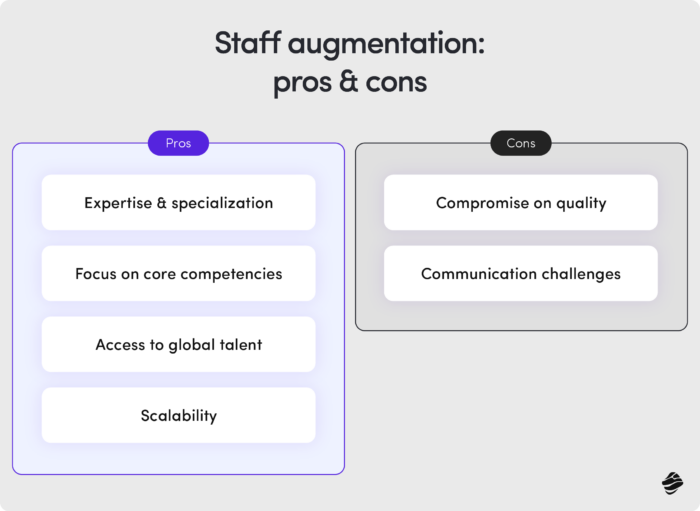
This article will delve further into the key IT staff augmentation challenges you might encounter. Let’s get started!
Core IT staff augmentation challenges
Staff augmentation projects face unique challenges that require careful consideration and, often, proactive management. Here is an overview of some of the core challenges in staff augmentation projects:
- Cultural clashes: Your in-house team is already accustomed to specific workplace culture and organizational values, which your augmented staff might have a hard time embracing. This potentially leads to friction that hinders collaboration and ultimately affects productivity.
- Communication barriers: Remote staff segmentation creates an environment where team members are geographically dispersed. This makes communication issues like language or cultural differences and time zone variations inevitable.
- Team integration: Seamless integration of augmented staff with in-house teams is essential for fostering collaboration, knowledge sharing, and team synergy. However, achieving cohesion between disparate teams with varying skill sets, backgrounds, and working styles is challenging.
- Technical challenges: Seamless collaboration requires ensuring that all team members, regardless of location, have access to the necessary tools, infrastructure, and technologies. Unfortunately, this will not happen without compatibility issues, cybersecurity concerns, and disparities in technological proficiency.
- Legal and compliance issues: While staff augmentation gives you access to a vast talent pool globally, the downside is the legal and compliance issues it may cause. You will need to navigate issues related to work visas, employment contracts, tax regulations, and labor laws across different jurisdictions.
- Varying expectations: Your in-house staff and augmented team might have a different understanding of the project, their roles, and the expected outcomes. Therefore, if you don’t set clear project outcomes and tasks from the start, you will end up with a stalled project or an unsatisfactory product.
- Security risks: Considering you are bringing in external team members into your internal procedures, security risks are an inevitable challenge. You must constantly ensure your augmented staff is adhering to intellectual property and data security protocols by having confidentiality agreements.
- Scalability: Rapid scalability demands can strain existing teams and processes. Additionally, the time it takes to onboard new team members and fully integrate them into existing workflows can easily affect your project timelines and deliverables.
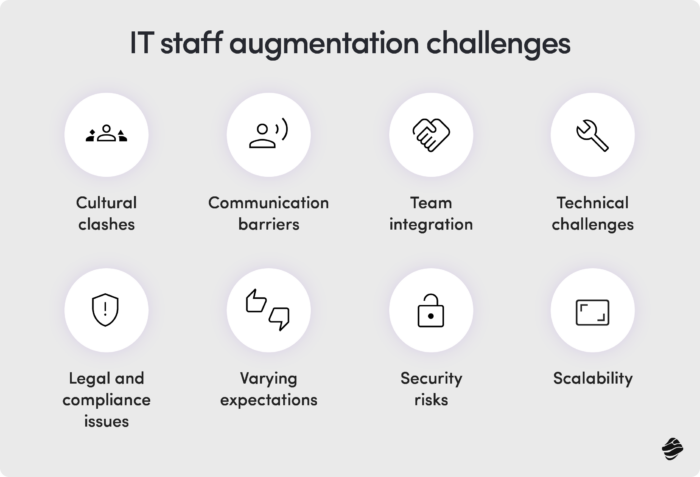
By addressing these IT staff augmentation challenges, you can enhance the effectiveness of your staff augmentation projects and unlock the full potential of your augmented workforce.
Implications of remote work environments on staff augmentation
Though remote work has been there for a while, it was not until the COVID-19 pandemic that the trend really caught on.
Research by McKinsey found that 20-25% of the workforce in advanced economies can work remotely between three and five days a week after the pandemic. This is four to five times more than pre-pandemic.
So, naturally, remote work has altered the staff augmentation landscape and will most likely continue to do so.
The first remote work implication is collaboration since team members are dispersed across different locations. For instance, offshore developers will experience more collaboration challenges due to time zone variations and possible language barriers.
Learn more about this in our offshore vs onshore app development guide.
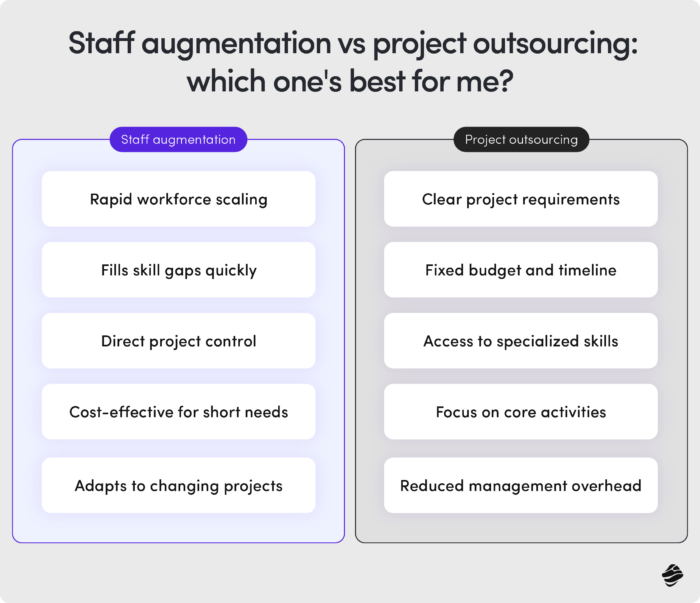
Remote teams may also struggle to adapt to the organization’s culture when they’re not physically present in the workplace. This can lead to isolation and detachment, affecting morale and productivity.
While remote work offers flexibility, it also blurs the boundaries between work and personal life. This eventually leads to burnout and decreased productivity. To avoid this, organizations should promote work-life balance initiatives that support the augmented team’s well-being.
Strategies to ensure seamless integration
You must successfully integrate your augmented staff and existing teams to execute your IT staff-augmented projects. Here are several strategies that will help you achieve seamless integration:
- Create a tailored onboarding process: Design a great onboarding process specifically tailored to augmented staff. It should provide them with essential information about the organization’s culture, values, and goals. You can even assign mentors or buddies from the existing team to help guide them through the process.
- Establish clear communication channels: You can successfully integrate the two teams only with effective communication. So, use great project management software, instant messaging platforms, and video conferencing tools to ensure clear communication regardless of location.
- Provide training and skill development: Offer training and skill development opportunities to both augmented staff and current team members to enhance their knowledge and capabilities.
For instance, you can use some of your existing team members to show the augmented team your company’s best practices and how to maintain an app and even take them through other vital in-house processes. This is the only way to build an effective integrated development team.
Additionally, ensure you offer resources to help them navigate cultural differences and work effectively in diverse teams.
Don’t forget to conduct regular check-ins to assess the progress of integration efforts and promptly address any challenges or concerns. You must also provide constructive feedback and support to augmented staff to help them adapt to their new roles effectively.
Legal and compliance staff augmentation challenges
It’s important that you understand the legal and compliance IT staff augmentation challenges your organization might face. This is especially vital once you start doing international staff augmentation. Identifying and resolving these issues will help you avoid potential legal liabilities and disputes.
Start by creating great employment contracts. These contracts should address key aspects such as responsibilities, compensation, termination clauses, and intellectual property rights. The contract will protect your interests and those of the team augmentation services provider.
Comply with work visa requirements and immigration regulations when hiring augmented staff that you need to move from foreign countries.
Alternatively, if you are working with remote augmented staff, comply with the labor laws and regulations where augmented staff are located. Some of the regulations you must pay attention to include working hours, wages, statutory deductions, and health and safety standards.
Also, ensure you comply with data privacy regulations, especially if handling confidential or personal information. For instance, you can ensure you comply with the General Data Protection Regulation (GDPR) when working within the EU.
Managing expectations and responsibilities
As we discussed earlier, managing the expectations and responsibilities of both augmented and in-house staff is one of the core IT staff augmentation challenges.
To avoid it, ensure you have a project scope statement outlining requirements and expectations from the outset. The statement should outline timelines, team members, project goals, project budget, stakeholders, and workflow strategies.
Create a chart that clearly defines the roles and responsibilities of augmented staff within the project team. If, say, an augmented expert is offering product strategy consulting services, there should be no confusion about who they should report to and those they oversee.
Also, maintain open and transparent communication between your organization and the staff augmentation services provider. This will keep every team member informed about the project at all times.
The regular updates will also provide opportunities for both parties to review progress and address any issues or concerns, enhancing project success.
Addressing technological challenges
To avoid technical challenges, first, ensure all team members have similar tools and technologies. This includes compatible hardware, software, communication tools, collaboration tools, and network access to facilitate workflow integration.
Your infrastructure should be scalable to accommodate growing team sizes and flexible enough to adapt to changing project requirements.
Train your augmented staff on using these tools and platforms effectively to collaborate with the rest of the team.
Also, ensure your augmented staff adheres to cybersecurity protocols and best practices to mitigate the risk of data breaches or unauthorized access.
Impact of staff augmentation challenges on IT projects
The IT staff augmentation challenges we’ve discussed can have a significant impact on project outcomes and team dynamics.
Misaligned teams and communication barriers can lead to decreased productivity and collaboration. Besides that, the lack of team integration can disrupt workflows.
Technological challenges, like infrastructure compatibility issues and cybersecurity concerns, will also stall the project. Additionally, legal and compliance issues may result in delays or legal disputes, impacting project timelines and budgets.
Ultimately, the collective impact of these challenges can affect team morale, project quality, and the overall success of your staff augmentation strategy. This is why it’s essential to identify the specific challenges facing your augmented team and work towards resolving them.
Let’s look at another key element that will impact your IT staff augmentation efforts.
Cost analysis: Staff augmentation vs. In-house employees
Staff augmentation is more cost-effective upfront since you avoid overhead costs associated with full-time employees, like long-term salaries, benefits, office space, equipment, and training.
With augmentation, you must account for the cost of hiring experts based on the project length and type. Hence, companies typically save around 30% by choosing staff augmentation over in-house hiring.
The current average cost-per-hire in traditional hiring is $4,683. Use the cost-per-hire formula to measure recruitment costs.
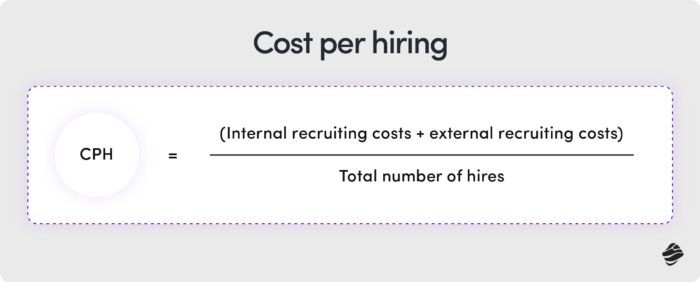
Additionally, augmentation is more likely to have better ROI in the short term since you can quickly mobilize skilled professionals to speed up project launch times.
However, while more costly upfront, in-house hiring can be more cost-effective over time if you’re looking for stability or have long-term demand for certain IT skills.
So, ensure you do a cost analysis beforehand to understand the best option for your company. For instance, if you’re creating an app, have a clear answer to the question: How much does it cost to make an app with an integrated team compared to my in-house team alone?
Future trends in IT staff augmentation
So, how’s the future looking for IT staff augmentation?
The integration of artificial intelligence (AI) and automation technologies into IT staff augmentation processes is expected to continue growing. More companies will embrace AI-driven algorithms throughout the recruitment process, from sourcing to finding the ideal talent.
AI Kickstarter: One framework to fast-track your AI apps
AI Kickstarter is an AI framework developed by Miquido. It facilitates the development of reliable, context-aware, and scalable apps and tools at a pace 3x quicker than solutions built from scratch. Plus – with much more security, flexibility, and effectiveness than generic, pre-made options.
It utilizes a powerful Retrieval-Augmented Generation architecture to turn large language models into potent business tools. Thanks to RAG, you can use your unique knowledge and data to produce accurate, relevant, and tailored outputs. All without the need for costly, restrictive fine-tuning.
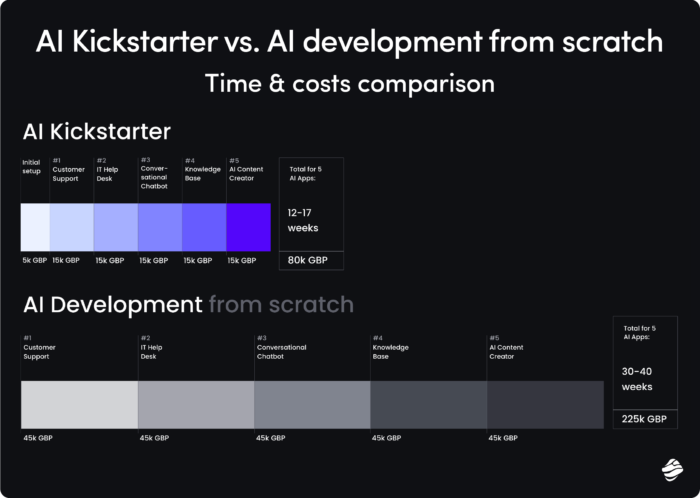
As technology advances, we will also see more companies embrace niche staffing to get access to hyper-specialized skill sets that will help them stay competitive.
For example, there’s a growing demand in cybersecurity, cloud computing, custom app development, data science, and artificial intelligence. Most companies will have to look for talent overseas to meet this demand.
In closing: Challenges in staff augmentation projects
IT staff augmentation is a powerful solution for addressing IT talent shortages, enhancing project completion, and driving innovation. However, the model has challenges that can easily affect project quality and internal team morale.
Common challenges include cultural clashes, communication barriers, poor team integration, technical challenges, legal issues, and misaligned expectations.
But even with these challenges, staff augmentation remains a great staffing solution. So don’t let them stop you! By proactively mitigating these challenges, you can enjoy the scalability, flexibility, and cost-effectiveness staff augmentation offers.








